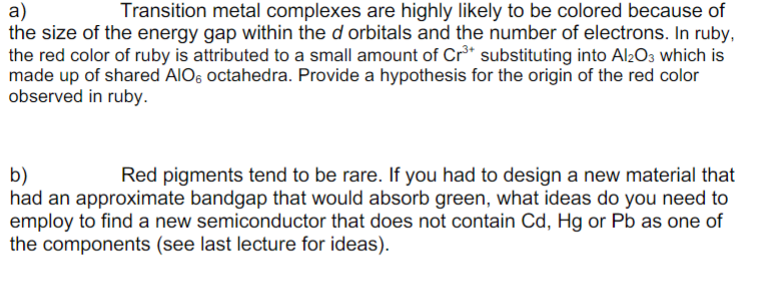a) Transition metal complexes are highly likely to be colored because of the size of the energy gap within the d orbitals and the number of electrons. In ruby, the red color of ruby is attributed to a small amount of Cr* substituting into AlżO3 which is made up of shared AIO6 octahedra. Provide a hypothesis for the origin of the red color observed in ruby. Red pigments tend to be rare. If you had to design a new material that b) had an approximate bandgap that would absorb green, what ideas do you need to employ to find a new semiconductor that does not contain Cd, Hg or Pb as one of the components (see last lecture for ideas).
a) Transition metal complexes are highly likely to be colored because of the size of the energy gap within the d orbitals and the number of electrons. In ruby, the red color of ruby is attributed to a small amount of Cr* substituting into AlżO3 which is made up of shared AIO6 octahedra. Provide a hypothesis for the origin of the red color observed in ruby. Red pigments tend to be rare. If you had to design a new material that b) had an approximate bandgap that would absorb green, what ideas do you need to employ to find a new semiconductor that does not contain Cd, Hg or Pb as one of the components (see last lecture for ideas).
Chemistry by OpenStax (2015-05-04)
1st Edition
ISBN:9781938168390
Author:Klaus Theopold, Richard H Langley, Paul Flowers, William R. Robinson, Mark Blaser
Publisher:Klaus Theopold, Richard H Langley, Paul Flowers, William R. Robinson, Mark Blaser
Chapter19: Transition Metals And Coordination Chemistry
Section: Chapter Questions
Problem 44E: Trimethylphosphine, P(CH3)3, can act as a ligand by donating the lone pair of electrons on the...
Related questions
Question

Transcribed Image Text:Transition metal complexes are highly likely to be colored because of
a)
the size of the energy gap within the d orbitals and the number of electrons. In ruby,
the red color of ruby is attributed to a small amount of Cr³* substituting into Al2O3 which is
made up of shared AIO, octahedra. Provide a hypothesis for the origin of the red color
observed in ruby.
Red pigments tend to be rare. If you had to design a new material that
b)
had an approximate bandgap that would absorb green, what ideas do you need to
employ to find a new semiconductor that does not contain Cd, Hg or Pb as one of
the components (see last lecture for ideas).
Expert Solution
This question has been solved!
Explore an expertly crafted, step-by-step solution for a thorough understanding of key concepts.
This is a popular solution!
Trending now
This is a popular solution!
Step by step
Solved in 2 steps

Knowledge Booster
Learn more about
Need a deep-dive on the concept behind this application? Look no further. Learn more about this topic, chemistry and related others by exploring similar questions and additional content below.Recommended textbooks for you

Chemistry by OpenStax (2015-05-04)
Chemistry
ISBN:
9781938168390
Author:
Klaus Theopold, Richard H Langley, Paul Flowers, William R. Robinson, Mark Blaser
Publisher:
OpenStax


Chemistry: An Atoms First Approach
Chemistry
ISBN:
9781305079243
Author:
Steven S. Zumdahl, Susan A. Zumdahl
Publisher:
Cengage Learning

Chemistry by OpenStax (2015-05-04)
Chemistry
ISBN:
9781938168390
Author:
Klaus Theopold, Richard H Langley, Paul Flowers, William R. Robinson, Mark Blaser
Publisher:
OpenStax


Chemistry: An Atoms First Approach
Chemistry
ISBN:
9781305079243
Author:
Steven S. Zumdahl, Susan A. Zumdahl
Publisher:
Cengage Learning

Chemistry
Chemistry
ISBN:
9781305957404
Author:
Steven S. Zumdahl, Susan A. Zumdahl, Donald J. DeCoste
Publisher:
Cengage Learning

Chemistry & Chemical Reactivity
Chemistry
ISBN:
9781133949640
Author:
John C. Kotz, Paul M. Treichel, John Townsend, David Treichel
Publisher:
Cengage Learning

Chemistry & Chemical Reactivity
Chemistry
ISBN:
9781337399074
Author:
John C. Kotz, Paul M. Treichel, John Townsend, David Treichel
Publisher:
Cengage Learning